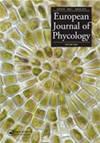Cell fine structure and phylogeny of Parvodinium: towards an ultrastructural characterization of the Peridiniopsidaceae (Dinophyceae)
IF 1.7
4区 生物学
Q2 MARINE & FRESHWATER BIOLOGY
引用次数: 2
Abstract
Abstract Recent molecular phylogenies that include species of Parvodinium revealed as its closest relatives the genera Peridiniopsis, Palatinus and Johsia. The clade containing these taxa is currently recognized as a family, Peridiniopsidaceae. The affinity between the members of Peridiniopsidaceae cuts across traditional boundaries based on features of the amphiesma, most notably the presence or absence of an apical pore complex. Detailed descriptions of the fine structure of Peridiniopsis and Palatinus are available from TEM studies of their type species. Here we provide a description in comparable detail of a species of the Parvodinium umbonatum–inconspicuum complex, which includes the type of the genus. The cells had an apical fibrous complex essentially similar to those described from other peridinioids prepared with comparable fixations. The pusular system was extensive and included areas with different aspects: an area with a sheet-like vesicle along the mid-right side of the cell, a ventral portion with ramified and anastomosed tubes and a somewhat flattened tube attached to the transverse flagellar canal. The most remarkable feature was the microtubular strand that extended from a ventral, protruding peduncle to the anterior part of the epicone, around an accumulation body, and came around along a more dorsal position toward the ventral side. This long microtubular strand of the peduncle (MSP) was reminiscent of the one described from Peridiniopsis borgei, both by its extension and looping path, and by the breaking up of the strand of microtubules into smaller portions with a wavy appearance; and contrasted with the reduced MSP of Palatinus apiculatus. The fine-structural features currently known from Peridiniopsidaceae are summarized. Members of the family include a flagellar apparatus with four microtubule-containing roots associated, the basal bodies inserted close to each other, nearly at right angles and a three-armed fibrous connective between root 1 and the transverse basal body. HIGHLIGHTS Detailed fine structure of Parvodinium (of P. umbonatum–P. inconspicuum complex). Comparative analysis of the ultrastructure of Parvodinium and other Peridiniopsidaceae. Summary of ultrastructural features of the family Peridiniopsidaceae.Parvodinium的细胞精细结构和系统发育:Peridiniopsidaceae(Dinophyceae)的超微结构特征
摘要最近的分子系统发育包括Parvodinium属的物种,揭示了其近亲Peridiniopsis属、Palatinus属和Johsia属。包含这些分类群的分支目前被认为是一个科,Peridiniopsidaceae。Peridiniopsidaceae成员之间的亲和力跨越了基于两栖动物特征的传统界限,最显著的是顶端孔复合体的存在或不存在。Peridiniopsis和Palatinus的精细结构的详细描述可从其模式物种的TEM研究中获得。在这里,我们提供了一个相当详细的描述,其中包括该属的类型。细胞具有顶端纤维复合体,基本上类似于用类似的固定剂制备的其他类周苷中所描述的那些。脓疱系统是广泛的,包括具有不同方面的区域:一个沿着细胞右中侧具有片状囊泡的区域,一个具有分支和吻合管的腹侧部分,以及一个连接在横向鞭毛管上的稍微扁平的管。最显著的特征是微管链,它从腹侧突出的蒂延伸到上颚的前部,围绕着堆积体,并沿着更靠背的位置向腹侧延伸。这种长的蒂微管链(MSP)让人想起了来自伯吉Peridiniopsis borgei的描述,无论是通过其延伸和成环路径,还是通过将微管链分解成波浪状的较小部分;并与刺桐降低的MSP形成对照。综述了目前已知的紫苏科植物的精细结构特征。该家族的成员包括一个鞭毛器,其具有四个相关的含有微管的根,基体彼此靠近,几乎成直角插入,以及根1和横向基体之间的三臂纤维结缔组织。亮点Parvodinium(P.umbonatum–P.unspicuum复合体)的详细精细结构。紫苏科植物与紫苏属植物超微结构的比较分析。文章题目紫苏科植物的超微结构特征。
本文章由计算机程序翻译,如有差异,请以英文原文为准。
求助全文
约1分钟内获得全文
求助全文
来源期刊

European Journal of Phycology
生物-海洋与淡水生物学
CiteScore
4.80
自引率
4.20%
发文量
37
审稿时长
>12 weeks
期刊介绍:
The European Journal of Phycology is an important focus for the activities of algal researchers all over the world. The Editors-in-Chief are assisted by an international team of Associate Editors who are experts in the following fields: macroalgal ecology, microalgal ecology, physiology and biochemistry, cell biology, molecular biology, macroalgal and microalgal systematics, applied phycology and biotechnology. The European Journal of Phycology publishes papers on all aspects of algae, including cyanobacteria. Articles may be in the form of primary research papers and reviews of topical subjects.
The journal publishes high quality research and is well cited, with a consistently good Impact Factor.
 求助内容:
求助内容: 应助结果提醒方式:
应助结果提醒方式:


